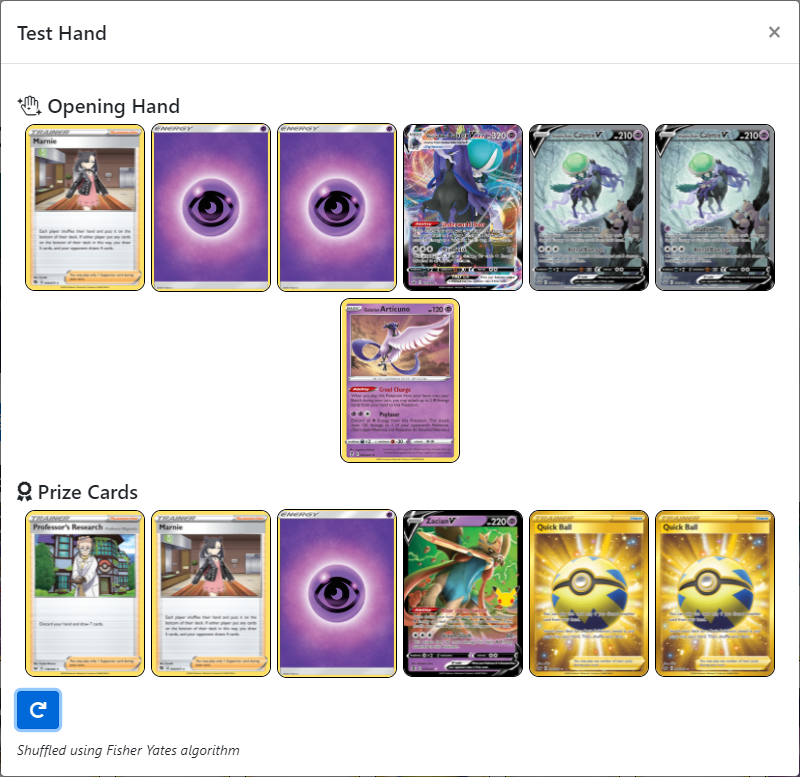Testing
Before You Test
Before your very first tests, it’s a good idea to give the deck one last look over to make sure there’s nothing critical that’s been forgotten. The Functional Deck Checklist is a very basic checklist, but it’s a fast way to ensure that you’ve included the basic components of a functioning deck.
- The deck contains exactly 60 cards.
- The deck contains at least one Basic Pokémon.
- All cards in the deck are legal in the format for which the deck has been built.
- The deck does not break the Rule of Four and any Prism Star cards included have at most one copy included in the deck.
- The deck contains all necessary evolution stages for each fully evolved Pokémon it contains.
- The deck contains energy for its Main Attacker, if necessary.
- The deck contains draw supporters.
- The deck contains Pokémon search cards.
- The deck includes a form of gusting.
- If the deck contains a Stage 2 Pokémon, the deck contains Rare Candy or an alternate means of accelerating evolution.
If something pops out at you from the checklist, run through your deck again to make sure you’ve got what it needs. Once you’re done looking over your deck, it’s time to start looking at testing it.
Early Testing
When trying out a new deck idea, it’s often a good idea to put your idea through a few basic tests before trying it out in the real world. These very basic types of testing are a great way to identify basic problems with your deck so that they can be fixed before your first games with it.
Goldfishing
Goldfishing, or playing without an opponent, is a simple way to begin testing your deck. When goldfishing, a player begins setting up play as normal, drawing a starting hand, choosing a starting Pokémon, placing prizes, and so on. The player then continues playing, setting up Pokémon, and attacking, progressing against their imaginary opponent. While goldfishing does not and cannot help you in many ways, goldfishing can be especially helpful in identifying basic consistency issues.
If you find your deck Bricking or Dead Drawing—becoming unable to draw into any cards that help you progress toward victory—with any significant degree of frequency, it may be time to head back to the drawing board. Often, Bricking is the result of a single deck trying to do too much. If your deck struggles to set itself up, even without an opponent, it needs more work. To quote Tord Reklev, “Your deck will never win if it can't function in the first place.”
Pokemoncard.io has an excellent Sample Hand and Prizing simulator built into its deck editor.
Typically, goldfishing requires you to have a physical copy of the deck you intend to test. However, the website Pokemoncard.io has a Sample Hand function in its deck editor that can help you with basic goldfishing of your starting hands before you have one. In the example above, the Shadow Rider Calyrex VMAX player has started with a reasonably decent hand—they have a pair of Shadow Rider Calyrex V and a couple of Energy for their first turn, and both a Marnie and a Shadow Rider Calyrex VMAX for their second.
Testing Against the AI Online
PTCGL is a great place to start testing your decks—and a great place to play against lots of other people’s decks, too!
An alternative to goldfishing is playing against the computer player in the Test Deck feature on the Pokémon Trading Card Game Live—or PTCGL. The Pokémon Trading Card Game Live offers ways to play with your deck in an online environment, both against computer players and against other players. Testing against the computer is a great alternative to goldfishing as it puts you up against a very easy opponent, allowing you to focus more on what is and isn’t working in your deck than how to not immediately lose. The game’s digital nature also makes it relatively easy to test several variations of a deck in quick succession—you can try out a handful of different draw supporters for your deck, for example, to see which best suits its needs.
Getting the cards you need to construct your deck on PTCGL is a separate process from collecting the cards you need in print, however, and to play against other players on PTCGL, you’ll need to obtain the cards for your deck in the game client. A benefit to PTCGL is that you don’t need to own the cards to test a deck against the computer, so if you just want to test an idea or two, or maybe how a change or two affects your deck’s consistency, PTCGL’s Test Deck feature will prove especially useful for you.
Initial Playtesting
So, you’ve got your deck and you’re feeling pretty good about how it’s working. Now, it’s time to actually put in some proper games with it. One of the best ways to start playing your freshly-crafted deck is to bring it to your local Pokémon League. You can find your closest Pokémon League using the Event Locator on Pokémon.com.
If you aren’t able to attend your local Pokémon League, or if you’d like to play your deck more often, there is also the option of playing online via PTCGO. Initial playtesting is often little more than a casual game with other players. Initial playtesting helps you run your deck against a variety of possible matchups, helps you focus your skills on learning to play your deck better, and helps you to see holes wherever they may be.
Always make notes, mental or otherwise, while playtesting. Always be asking yourself these four questions:
What cards did you not see when you needed them?
What cards did you see too often?
Were your attackers able to win you the prize trade?
What cards did you find yourself wishing you had in your deck?
Focused Playtesting
As you begin to gear up for your first tournament—perhaps a League Challenge or League Cup—you’ll want to prepare your deck to be ready to take on the most popular decks in the current meta. It’s helpful to know what decks have been winning recent Standard tournaments so that you can try to test against these decks specifically. Limitless TCG provides an excellent resource for recent tournament results. Plan to test against decks that have made it into the top 8 in the last month or so of tournaments.
Decks that have done well at recent large tournaments like Regionals and Internationals are especially popular with many players so being prepared to play against these decks can be especially helpful when preparing for your first tournament with your new deck. If possible, play against players who regularly play and regularly win using these top decks. Players that are more experienced with these meta decks are more likely to provide more useful testing games.
As with initial testing, continue to make notes about your deck as you test.
Cutting Cards
As you play your deck more and more, you may find that cards you’d thought would be especially helpful for your deck often end up never being used. In such situations, it’s often the case that Cutting a card, or removing it from the deck in favor of some other card, would benefit your deck. In a Seagrove TCG video titled Deckbuilding with Tord Reklev, Tord Reklev said the following:
"Play a lot of games with your deck and see which cards you're actually using to win games. So, if you really like a card, but you never use it—if you play ten games and you still haven't used your card—then you should probably drop that card. Even though it could be really good against that one deck and situation, it's honestly not worth it anymore. So, try to make sure that you actually use all the cards in your deck. If you see that the card is not used and/or that the card is weak then you should probably swap it for something better."
Now that you’ve done some testing, you can start to see where your deck’s weak spots are. Review your notes from your playtesting. Reduce counts for cards that you’re seeing too often, increase counts for cards that you need to see more often. Swap secondary attackers, if necessary. Exchange one utility Pokémon for another if it may be beneficial. Include cards you found yourself wanting.
Tournament Time
Your deck has been thoroughly-tested and is battle-hardened and ready for a tournament. Refer to your local Pokémon League or to the Event Locator on Pokémon.com to see tournaments taking place nearby. Alternatively, step into a tournament with your deck on the Pokémon Trading Card Game Online.
In many ways, a deck is like a living, breathing thing. It will evolve the more you play it. You won’t win every game—even the best players lose from time to time. But as you learn how best to play the deck you’ve crafted, you’ll make changes that make it better and better. Every game is a playtest.
Moving On
Sometimes, the last stage in testing a deck isn’t a tournament, it’s moving on. Not every deck idea is gold—many simply won’t work at all. The important thing is to learn from your testing even for decks that don’t end up working out. Get a feel for how cards interact with one another, what counts of cards are ideal, and for how best to turn your latest failure into your next success.


